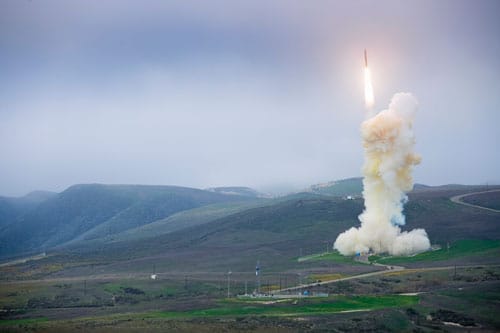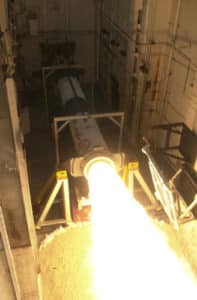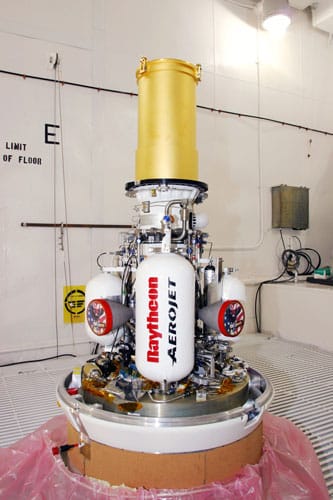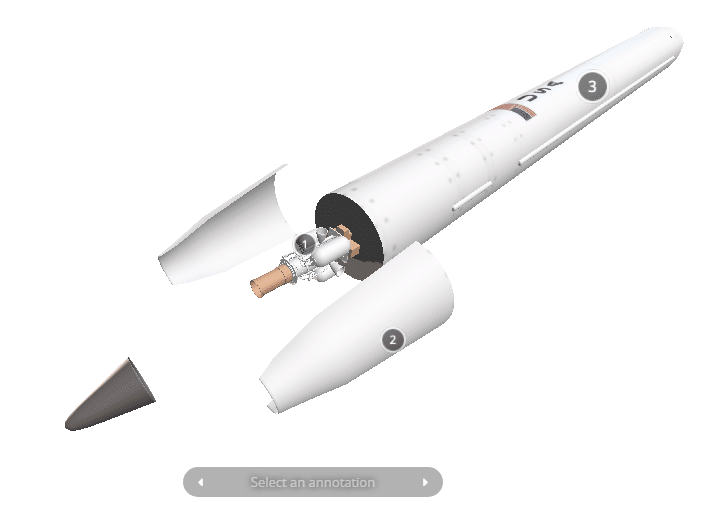The Ground-based Interceptor (GBI) is a component of the Ground-based Midcourse Defense (GMD) System. GBIs are silo-launched and intercept ballistic missiles in their midcourse, while they are outside of the atmosphere and at their highest trajectory. The GBI consists of a multi-stage rocket booster (Boost Vehicle [BV]) and a kinetic kill vehicle (Exoatmospheric Kill Vehicle [EKV]), which makes interception of ballistic missile warheads possible using hit-to-kill technology.
GBI Program History
Predecessors of today’s GBIs, including the Homing Overlay Experiment (HOE) and the Exoatmospheric Reentry Interceptor Subsystem (ERIS), used two stages from a Minuteman I Intercontinental Ballistic Missile (ICBM) fitted with a Kinetic Kill Vehicle (KKV) to form hit-to-kill interceptors. HOE used the first two stages of a Minuteman I as a boost vehicle and deployed an umbrella-like KKV with weights on the ribs of the unfolding kill vehicle to destroy the target missile.1
The ERIS interceptor used the second and third stages of the Minuteman I and a smaller inflatable octagonal “kill enhancer” KKV.2
Clinton Administration
The GBI program began as the interceptor portion of the National Missile Defense (NMD) architecture developed by the Clinton Administration. The Clinton strategy called for a phased deployment of GBIs that would initially fall under ABM Treaty limits with 100 interceptors deployed at one site at the end of phases one and two. The third and final phase assumed a reworking of the treaty to accommodate a slightly larger deployment of 250 interceptors over two sites in Grand Forks, North Dakota and Fort Greely, Alaska.3
In 1997, the Ballistic Missile Defense Organization (BMDO) formed the initial Joint Program Office for the NMD program with the goal of conducting an integrated test in 1999 and an initial operational deployment in 2003.4

Early tests of the NMD systems used surplus stages of Minuteman missiles as boost vehicles, allowing the first fly-out test to occur in 1997 for the prototype EKV and the first successful intercept test in October 1999.5 Clinton decided to push the decision on deployment of an initial capability of GBIs into the next administration.
Bush Administration
The direction of GBI deployment was handed off to the George W. Bush administration, which was more dedicated to the deployment of an effective homeland missile defense. In 2002, the Bush administration withdrew from the ABM Treaty, effectively removing any limits on the amount of GBIs and the number of sites they could be deployed at. The Bush plan called for an initial deployment capability by 2004 and the system grew to include 44 GBIs at two sites in the United States, Fort Greely, Alaska and Vandenburg Air Force Base, California, and an additional 10 GBIs at a site in Poland.6
Obama Administration
In 2009, the newly elected Obama administration announced its intention to reverse the Bush plan to deploy GBI at a site in Poland in favor of a Phased Adaptive Approach.7
They also decided to suspend the procurement of new GBIs at 30, abandoning the goal of 44 interceptors established by the Bush administration. 8
In 2010, the repeated failure in testing of the new CE-II kill vehicle resulted in a reorientation in the GBI program towards an emphasis on testing rather than deployment of new GBIs.9 The reinstitution of the 44 GBI target and a successful flight test of the new EKV in 2013 and then a successful intercept test in 2014 buoyed support for the system.10
On November 2, 2017, the U.S. MDA and industry emplaced the 44th interceptor at Ft. Greely.11
GBI Variants
President Bush’s 2002 decision to essentially fielded an advanced prototype resulted in every early kill vehicle being unique, handmade in about 130,000 steps. The gradual progress of modernization and increases in capacity have resulted in a further diversity in the actual interceptors deployed. These vary based on their combinations of the kill vehicle and booster.12
| Model | Kill Vehicle | Booster | 2017 Fleet |
| GBI Block 1 | CE-I | C1 | 20 |
| GBI Block 2A | CE-II | C1 | 16 |
| GBI Block 2B | CE-II Block 1 | C2 | 8 |
| GBI Block 3A | RKV (cancelled) | C1 | – |
| GBI Block 3B | RVK (cancelled) | C3 | – |
Flight Tests
GBI has undergone regular flight tests since 1997. It has recorded 10 successful intercepts out of 18 attempts.
| Name | Date | Intercept? | Description |
| FTG-15 | 30-May-17 | Y | – |
| GM CTV-02+ | 28-Jan-16 | n/a | Nonintercept test |
| FTG-06b | 22-Jun-14 | Y | Battery power loss |
| FTG-07 | 5-Jul-13 | N | Kill vehicle and booster did not separate |
| GM CTV-01 | 26-Jan-13 | n/a | Nonintercept test |
| FTG-06a | 15-Dec-10 | N | Track gate anomaly; KV guidance error in final seconds of flight |
| BVT-01 | 6-Jun-10 | n/a | 2-stage booster test only; Orbital Booster Vehicle |
| FTG-06 | 31-Jan-10 | N | Missing DACS lock wire, SBX malfunction |
| FTG-05 | 5-Dec-08 | Y | – |
| FTG-03a | 28-Sep-07 | Y | – |
| FTG-03 | 25-May-07 | n/a | No test (target failure) |
| FTG-02 | 1-Sep-06 | Y | – |
| FT-01 | 13-Dec-05 | n/a | Nonintercept test |
| IFT-14 | 14-Feb-05 | N | Failed to launch |
| IFT-13c | 15-Dec-04 | N | Failed to launch, software design error |
| IFT-13b | 24-Jan-04 | n/a | Successful test of Orbital Booster Vehicle |
| BV-5a | 9-Jan-04 | n/a | Successful booster test; Lockheed Martin BV + Vehicle |
| BV-6 | 16-Aug-03 | n/a | Successful booster test; Orbital Booster Vehicle |
| IFT-10 | 11-Dec-02 | N | EKV failed to separate |
| IFT-9 | 14-Oct-02 | Y | – |
| IFT-8 | 15-Mar-02 | Y | – |
| BV-3 | 13-Dec-01 | n/a | Flight test failure; Boeing Booster Vehicle |
| IFT-7 | 3-Dec-01 | Y | – |
| BV-2 | 31-Aug-01 | n/a | Boeing Booster Vehicle |
| IFT-6 | 14-Jul-01 | Y | – |
| BV-1 | 28-Apr-01 | n/a | Vehicle did not launch; Boeing Booster Vehicle |
| IFT-5 | 8-Jul-00 | N | Failed booster separation |
| IFT-4 | 19-Jan-00 | N | EKV foreign object coolant blockage |
| IFT-3 | 2-Oct-99 | Y | Single Decoy |
| IFT-2 | 15-Jan-98 | n/a | Flight test only |
| IFT-1a | 7-Jul-97 | n/a | Flight test only |
| IFT-1 | 17-Jan-97 | n/a | Data link malfunction-launch aborted |
Booster Development

Initial testing for the GBIs used surplus Minuteman ICBM stages as boosters to facilitate earlier testing of the kill vehicles. The first dedicated booster designed for the GBI program was the Commercial Off-the-Shelf (COTS) booster, which used commercial rocket stages to form a three-stage booster. The first flight test occurred in August 2001, 18 months behind schedule. A December 2001 test of the COTS interceptor resulted in the vehicle veering off course, forcing the destruction of the booster and cessation of testing of the booster.13
In March 2002, the booster program was transferred from Boeing to Lockheed Martin, which developed the BV-plus, an improved version of the COTS booster. In addition, Orbital Sciences Corp. was tasked with creating a competing booster known as the Orbital Booster Vehicle (OBV) which was based on the upper three stages of the commercial Taurus XL launch vehicle. The OBV was successfully tested in February and August 2003 and after delays and the eventual test failure of the BV-plus in 2004, the OBV was selected as the booster for the current GBI.14 In 2010, MDA successfully tested a two-stage version of the OBV booster from Vandenburg Air Force Base.15
In 2016, MDA plans to deploy an upgraded version of the three-stage boost vehicle design to improve reliability and resolve any hardware obsolescence. The project also involves upgrades to the avionics of the booster to provide better flight and booster controllers. MDA is also working on developing a two-stage booster rocket for the GBIs that would incorporate the successful design of the 2010 test and the upgrades of the second phase three-stage boost vehicle. Success in producing a two-stage GBI would allow shorter boost action times, allowing greater flexibility in the location of future deployments.16
Kill Vehicle Development
The Exo-atmospheric Kill Vehicle (EKV) is the GMD’s means of physically destroying incoming target missiles. The EKV consists of a sensor-propulsion package that collides with the re-entry vehicle during the midcourse phase of the missile’s ballistic trajectory, using its own infrared seeker, guidance system, and motor. As it closes in on its target, the EKV integrates data from the X-band radars with its on-board sensors and locks on to the enemy missile. The EKV continuously adjusts its flight path until it collides with the target. The hit-to-kill impact causes complete destruction of the warhead, including any nuclear, chemical, or biological agents.
The Capability Enhancement-I (CE-I), delivered in 2004, became the first deployed EKV for the GMD system.17 The CE-I was produced and delivered until September 2007 with a peak deployment of 24. In all, 33 CE-I kill vehicles were produced and six were expended in tests.18
The accelerated timelines for the initial delivery of the CE-I forced the designs to become a prototype that could demonstrate the viability of hit-to-kill while being deployed quickly. The designers upgraded the connectors to account for obsolescence issues on previous kill vehicles used in tests before the CE-I deployment and have continued to produce a number of subconfigurations to resolve other design and manufacturing issues.19
The second variant of EKV deployed on GBIs is the Capability Enhancement-II (CE-II), which MDA began designing in 2005.20 The CE-II features obsolescence upgrades for computer processors on CE-I that are designed to improve discrimination and a more sensitive infrared seeker. Changes to the algorithm also increased the processor throughput, again intending to enhance the ability of CE-II to discriminate targets from debris and decoys. After two unsuccessful intercept tests in 2010 due to the performance of the CE-II, MDA decided to halt procurement until the issues relating to the failed tests could be resolved. In January 2013, MDA conducted CTV-01, resulting in a successful flight test for the CE-II, followed by a successful intercept test in June 2014.21 Like the CE-I, the CE-II has a number of subconfigurations to resolve design and manufacturing problems encountered through the testing process.
Redesigned Kill Vehicle (RKV)

The FY2016 NDAA included significant funding for the development of new kill vehicle technologies including a Redesigned Kill Vehicle (RKV) and a Multi-Object Kill Vehicle (MOKV). The RKV was designed to improve on and eventually replace the existing fleet of prototype CE-I and CE-II EKVs.22 The RKV upgrades would “improve reliability, maintainability, producibility, and affordability,” according to MDA Director VADM James Syring’s 2015 Testimony before the Senate Appropriations Committee.23 The RKV was intended to incorporate enhancements in target acquisition and discrimination and on-demand communication to allow better use of alternative sensor data creating better situational awareness.
MDA plans the first flight test of the RKV for 2018 with the first intercept test to follow in 2019.
In August 2019, the Pentagon cancelled the RKV program following significant technical design problems.24 To keep up with rising missile threats, the Defense Department is instead opting to accelerate development of the Next Generation Interceptor (NGI), an advanced interceptor which will replace the GBI in the GMD system.
Multi-Object Kill Vehicle (MOKV)
The MOKV revived the concept of the previously cancelled Multiple Kill Vehicle (MKV), which began in 2004 and was cut by the Obama administration in 2009.25
The MOKV was designed to counter several incoming warheads or decoys simultaneously, therefore reducing the number of interceptors required to counter growing missile arsenals. Development of the concepts for the MOKV fall under the Common Kill Vehicle program, which also developed the concepts and requirements for the RKV. Even a successful MOKV program was not expected to produce a deployable interceptor until at least 2030, according to current estimates.
In May 2017, the Missile Defense Agency began accelerating MOKV development. The FY 2018 DoD budget request sought $259 million for the MOKV program for technology risk reduction and product development and speed up its projected completion by five years, “to achieve a demonstrated capability in the 2025 timeframe,” according to an MDA official.26 While U.S. defense officials did not provide a specific reason behind the acceleration, contemporaneous North Korean missile tests were likely a catalyst.27
With the cancellation of the RKV In August 2019, the MOKV was also cancelled, as it was based on RKV technology.
GBI Service Life Extension
With Next Generation Interceptor (NGI) deliveries required to begin “no later than 2028,” the Missile Defense Agency has embarked on an interim service life extension program (SLEP) for its existing GBIs. Beginning in Fiscal 2020, the GBI SLEP aims to significantly improve interceptor reliability and extend its service life beyond 2030, as NGI enters the force.28
Interactive Model
Footnotes
- Andreas Parsch, “Lockheed ERIS,” Directory of U.S. Military Rockets and Missiles, 2003, http://www.designation-systems.net/dusrm/app4/eris.html.
- Ibid.
- Lindsay, James M., and Michael E. O’Hanlon, Defending America: The Case for Limited National Missile Defense (Washington D.C.: Brookings Institution, 2001).
- “BMDO Forms New Joint Program Office,” DefenseLINK, April 3, 1997 http://osd.dtic.mil/news/Apr1997/m040397_m049-97.html.
- James D. Syring, “Homeland Missile Defense,” Presentation to 2014 Space and Missile Defense Conference, Huntsville, AL, August 13, 2014.”
- Steve Lambakis, The Future of Homeland Missile Defense (Fairfax, VA: National Institute Press, 2014.)
- Peter Baker, “White House Scraps Bush’s Approach to Missile Shield,” New York Times, September 17, 2009, http://www.nytimes.com/2009/09/18/world/europe/18shield.html.
- Jennifer Griffen, “Lawmakers Question Obama’s Missile Defense Cuts,” Fox News, June 16, 2009, http://www.foxnews.com/politics/2009/06/16/lawmakers-question-obamas-missile-defense-cuts.html.
- Syring, 2014.
- Thom Shanker, David E. Sanger, and Martin Fackler, “U.S. Is Bolstering Missile Defense to Deter North Korea,” New York Times, March 15, 2013, http://www.nytimes.com/2013/03/16/world/asia/us-to-bolster-missile-defense-against-north-korea.html.
- Jen Judson, “US installs final ground-based missile interceptor to counter ICBM threat,” Defense News, November 7, 2017, https://www.defensenews.com/land/2017/11/07/final-ground-based-missile-defense-interceptor-in-place-at-fort-greely/.
- Missile Defense Project, “Ground-based Interceptor Development,” Missile Threat, Center for Strategic and International Studies, April 7, 2017, last modified April 27, 2021, http://missilethreat.csis.org/ground-based-interceptor-development/.
- Andreas Parsch, “Boeing Ground-Based Interceptor (GBI),” Directory of U.S. Military Rockets and Missiles, 2003-2007, http://www.designation-systems.net/dusrm/app4/gbi.html.
- Ibid.
- Turner Brinton, “Two-Stage Interceptor Missile Succeeds in First Flight Test,” Space News, June 7, 2010, http://spacenews.com/two-stage-interceptor-missile-succeeds-first-flight-test/#sthash.hWQa6aP2.dpuf.
- Syring, 2014.
- Ibid.
- “EKVs, RKVs, CKVs, MOKVs and More,” mostlymissiledefense, April 26,2015, http://mostlymissiledefense.com/2015/04/26/ekvs-rkvs-ckvs-mokvs-and-more-april-26-2014.
- U.S. Inspector General, “Exoatmospheric Kill Vehicle Quality Assurance and Reliability Assessment – Part A,” Report No. DODIG-2014-111, (Alexandria, VA: Department of Defense.)
- mostlymissiledefense, 2015.
- Syring, 2014.
- Missile Defense Project, “Ground-based Interceptor Development,” Missile Threat, Center for Strategic and International Studies, April 7, 2017, last modified June 15, 2018, https://missilethreat.csis.org/ground-based-interceptor-development/.
- James D. Syring., “Unclassified Statement of Vice Admiral J.D. Syring, USN Director, Missile Defense Agency Before the Senate Appropriations Committee Subcommittee on Defense,” March 18, 2015, http://www.mda.mil/global/documents/pdf/ps_syring_031815_sacd.pdf.
- Jen Judson, “Pentagon terminates program for redesigned kill vehicle, preps for new competition,” Defense News, August 21, 2019, https://www.defensenews.com/pentagon/2019/08/21/dod-tanks-redesigned-kill-vehicle-program-for-homeland-defense-interceptor/.
- Mike Gruss, “House Bill Would Revive Dormant Missile Defense Kill Vehicle Project,” Space News, May 11, 2015, http://spacenews.com/house-bill-would-revive-dormant-missile-defense-kill-vehicle-project/#sthash.TMz4vVNl.dpuf.
- Patrick Tucker, “Pentagon Accelerates Work on Multi-Warhead Interceptor,” Defense One, May 26, 2017, https://www.defenseone.com/technology/2017/05/Pentagon-Accelerates-Work-on-Multi-Warhead-Interceptor/138213/.
- Missile Defense Project, “US Accelerates Work on Multi-Object Kill Vehicle,” Missile Threat, Center for Strategic and International Studies, June 5, 2017, last modified June 15, 2018, https://missilethreat.csis.org/us-accelerates-work-multi-object-kill-vehicle/.
- Hill 2021; Under Secretary of Defense (Comptroller), Department of Defense Fiscal Year (FY) 2022 Budget Estimates: Missile Defense Agency, Defense-Wide Justification Book Volume 2a of 5, (Washington, DC: U.S. Department of Defense, 2021), https://comptroller.defense.gov/Portals/45/Documents/defbudget/fy2022/budget_justification/pdfs/03_RDT_and_E/RDTE_Vol2_MDA_RDTE_PB22_Justification_Book.pdf.

